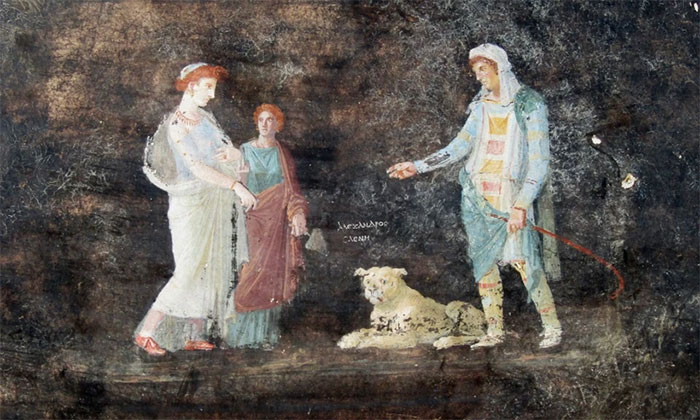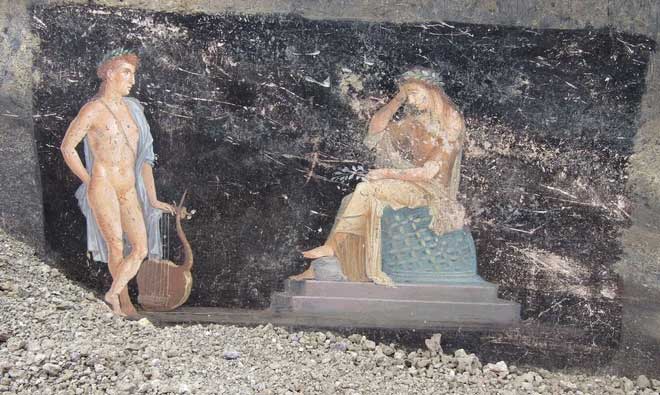Discovered frescoes of Trojan mythological characters in Pompeii
The "Black Room", with its beautiful frescoes inspired by the Trojan War, is considered one of the most outstanding archaeological discoveries ever made at Pompeii.
Nearly 2,000 years since it was buried by volcanic lava, the lost city of Pompeii continues to surprise archaeologists with new discoveries.

The fresco depicts Helen meeting Paris, prince of Troy, for the first time. (Photo: AFP/Getty Images).
While working at the Pompeii Archaeological Park (Italy) - one of the most famous archaeological sites in the world, archaeologists discovered a banqueting room with black painted walls decorated with ornaments. beautiful frescoes of mythological figures associated with the Trojan War.
This banqueting room, known as the "black room" was discovered in an old private residence on Via di Nola, one of the longest streets of ancient Pompeii.
One of the frescoes depicts the meeting between Helen and Paris, son of the Trojan king Priam, identified by a Greek inscription with the other name 'Alexandros' (another name for Paris).
In Greek mythology, Paris's kidnapping of Helen angered her Greek husband, Menelaus, and sparked the Trojan War in the 12th century BC.
Another fresco depicts the Greek god Apollo trying to woo the priestess Cassandra, daughter of Priam, who looks bored.

The fresco depicts the Greek god Apollo trying to woo the priestess Cassandra. (Source: Reuters).
According to legend, Apollo promised to give Cassandra the precious gift of prophecy if she agreed to his feelings. Cassandra accepted, but later, she dreamed of Apollo abandoning her, so she rejected Apollo. Apollo angrily punished her with a curse that no one would believe Cassandra's prophecies. As a result, the priestess was unable to prevent the fall of Troy that she had prophesied.
The third fresco in the black room shows Leda, mother of Helen of Troy, holding a swan.
Dr Andrew Sillett, a lecturer at Oxford University, explains: 'The swan is the Lord of Olympus, God Zeus'.

The fresco depicts Leda, mother of Helen of Troy, about to conceive with the Greek god Zeus disguised as a swan. (Source: Archaeological Park of Pompeii).
According to legend, Leda was the wife of Tyndareus, king of Sparta, who was infatuated with Zeus and seduced by him in the guise of a swan. Leda then conceived an egg, and from this egg hatched the twins Castor and Polydeuces.
Dr Sillett described the frescoes as 'quite amazing' as they were likely created close to the eruption of Mount Vesuvius.
Gabriel Zuchtriegel, Director of the Pompeii Archaeological Park, said the lavishly decorated banqueting room was intended to provide an elegant space with mythological figures, not only for entertainment but also as a topic of conversation during the ceremonies. party.
'Everyone will meet for dinner after Sundown. The flickering light from the lit oil lamps has the effect of making the images appear moving, especially after a few glasses of good Campanian wine' , says Gabriel Zuchtriegel, adding: 'The walls of The banquet room was painted black, possibly to hide traces of soot from the oil lamps used for lighting.
Meanwhile, the banquet room floor is intricately inlaid with more than a million very small and intricately arranged white tiles.
A press release from the Pompeii Archaeological Park said the black banquet room is about 15 meters long and 6 meters wide, opening to an inner courtyard with a long staircase leading to the second floor.

The elaborately decorated black banquet room provides an elegant setting for entertaining. (Source: Archaeological Park of Pompeii).
On the plaster of the stair arch, someone used charcoal to draw two pairs of gladiators and a shape that appeared to be a stylized giant penis.
Underneath the dome, a large pile of construction materials was also found.
The ancient city of Pompeii was destroyed and completely buried by a two-day eruption of Mount Vesuvius in AD 79. Pompeii was buried under 18 meters of ash and pumice.
The ruins were forgotten for the next 1,700 years until they were suddenly discovered in 1748.
According to the Pompeii Archaeological Park, the site has 1,070 houses with more than 13,000 rooms, as well as public and sacred spaces. This latest discovery was made during a major ongoing excavation.
Other finds revealed in the excavation area so far include two interconnected houses, a bakery, a laundry room and a living room decorated with beautiful frescoes.
- Wall paintings revealed activity in ancient brothels in Italy
- The secret of the ancient painting in Australia's grave
- The fake Trojan add-on Trojan is extremely dangerous
- The source of Pompeii style artefacts
- Hue: adding a discovery about ancient home decor art
- The incredible truth about couples hugging each other under the ashes 2,000 years ago
- The new Trojan bypasses the virtual keyboard face
- Archaeologists are amazed at the 5,000-year-old 'Scottish Pompeii' ruins
- Explain the mystery of the ancient tombs in Pompeii
- Add new Trojan for ransom
- Discovered an ancient character of 3,000 years resembling an airplane in Egypt
- The Trojan said the sentence ...
 Discovered an ancient centipede fossil 99 million years old
Discovered an ancient centipede fossil 99 million years old Discovered bat-like dinosaurs in China
Discovered bat-like dinosaurs in China Discovered a 200-year-old bronze cannon of the coast
Discovered a 200-year-old bronze cannon of the coast Discover 305 million-year-old spider fossils
Discover 305 million-year-old spider fossils